Lecture 4: Attention bottlenecks
1/42
There's no tags or description
Looks like no tags are added yet.
Name | Mastery | Learn | Test | Matching | Spaced |
|---|
No study sessions yet.
43 Terms
What is a serial bottleneck in human attention
The point at which it is no longer possible to take in and process further information from our senses in parallel: the point at which we select information that we will attend to
What do we mean by an early selection theory of attention
Early selection theories: Theories of attention proposing that the selection of information (serial bottlenecks) occur early in information processing
What do we mean by a late selection theory of attention
Theories of attention proposing that the selection of information (serial bottlenecks) occur late in information processing
What is the cocktail party phenomenon? (Cherry 1953)
How can we follow just one conversation when several people are talking all at the same time?
DESCRIBE THE DICHOTIC LISTENING TASK (Cherry 1953)
Participants wear a set of headphones
They hear 2 messages simultaneously (one in each ear)
Participants must ‘shadow’ one message and ignore the other
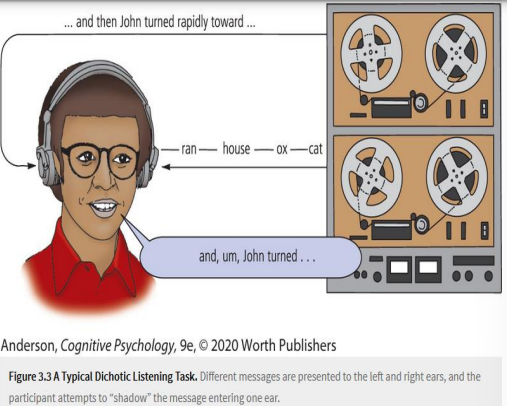
Cherry 1953: What semantic features did pps fail to hear in the unnattended message in her dichotic listening task
Message played backwards
Several words repeated
Message played in a foreign language
Cherry 1953: What physical features did pps fail to hear in the unnattended message in her dichotic listening task
Male or female speaker
Whether it was human or a noise
BRIEFLY describe Broadbent 1958 filter theory
Early selection theory
Sensory information comes in through the auditory system until it meets a filter
Attention acts on a perceptual level
Information is filtered based on physical features of information (such as pitch, the ear they are paying attention to), not the semantic features

What process does information follow in broadbents 1958 filter theory
Unattended info and attended info enters sensory memory
Both meet a filter
Attended information is filtered by physical features (i.e. pitch, the ear the message is played into)
Attended info passes through perceptual processes (Attention acts on a perceptual level)
Attended info enters STM

What did Moray 1959 find AGAINST broadbent’s filter theory
Asked what happens when we introduce the name of the participant in the non-shadowed message (irrelevant channel)
According to filter theory, they wouldnt be able to recognise that their name had even been said.
RESULTS = 33% of participants detected their name; they recognised semantic characteristics
How does Moray 1959 CHALLENGE filter theory 1958 (what are Moray 1959’s implications)
33% of pps heard their name in the unattended channel in a dichotic listening task - a semantic characteristic
This challenges filter theory as if filter theory were true, the pps would not have been able to process that their name had been said as, in theory, we only process physical characteristics of unattended messages, not semantic characteristics
What did Gray and Wedderburn 1960 find AGAINST filter theory 1958
Another dichotic listening task
Message 1: string of numbers (6, 2, 8)
Message 2: meaningful sentence (dogs scratch fleas)
They alternated the ear to which the words in the meaningful sentence was played
RESULTS: When asked to report what they had listened to, participants had no problems in reporting the meaningful sentence correctly
How does Gray and Wedderburn 1960 CHALLENGE filter theory 1959
When asked to report what they had listened to, participants had no problems in reporting the meaningful sentence correctly
This suggests that pps can alternate between channels (select information) based on the semantic proporties of the stimuli
This goes against broadbent as his theory suggests we can only select info based on physical proporties (attention is on a perceptual level
SO the filter/bottleneck must be elsewhere.
What did Triesman 1960 find AGAINST filter theory 1958
Another dichotic listening task
The meaningful message is switched to the other ear (non-shadowed ear)
You must always keep track of the message on the right, repeating that one out loud, even if it becomes non-meaningful
Results = Some participants switched ears and kept shadowing the meaningful message, breaking the instruction. Some others kept attending to the message in the first ear
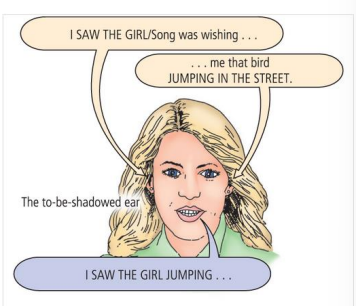
How does Treisman 1960 CHALLENGE filter theory
Some participants switched ears and kept shadowing the meaningful message, breaking the instruction. Some others kept attending to the message in the first ear
This suggests that the selection of information can be flexible
PPS can sometimes select info based on physical features, sometimes on semantics
Thus, another theory beyond filter theory is needed
SUMMARISE the criticisms against filter theory 1958
Moray 1959: pps heard their name in unattended channel; suggests we can process semantic features of info not just physical
Grey and Wedderburn: pps could attend to info in both ears, meaning they could alternate between channels based on the semantic proporties of stimuli. Filter must be elsewhere
Treisman 1960: some pps switched ears and attended to the meaningful message consistently, some continued attending to the correct ear. Information procesing can be flexible; sometimes on physical features, sometimes semantic. New theory needed.
Describe Treisman’s attenuation theory 1964
early selection theory
Information comes through the system until it meets an attenuator
Information is attenuated (weakened, e.g. reducing its volume or quality) not filtered out
Information can be selected based on a semantic selection criterion (e.g. meaning of the message)

How is Treisman’s attenuation theory DIFFERENT to filter theory
Filter theory suggests after entering sensory memory, information meets a filter. info is filtered on a perceptual basis, based on physical proporties
Attenuation theory suggests that after entering sensory memory, information meets an attenuator, reducing the volume or weakening the information coming in. info is then selected semantically.

What neural evidence is there to support attenuation theory?
Neural evidence suggests that not only is there attenuation of the signal from the unattended ear when listening to messages (signal is weakened/reduced volume), there is also enhancement of the signal coming from the attended ear.
What is Deutsch and D. Deutsch 1963 late selection theory
late selection theory
Information is processed completely (including physical and semantic proporties)
THE BOTTLENECK APPEARS AFTER PERCEPTUAL PROCESSES
The bottleneck (capacity limitation) is in the response system, not the perceptual system
AKA we can only respond to one type of information at a time

What are the differences between the 3 auditory attention theories
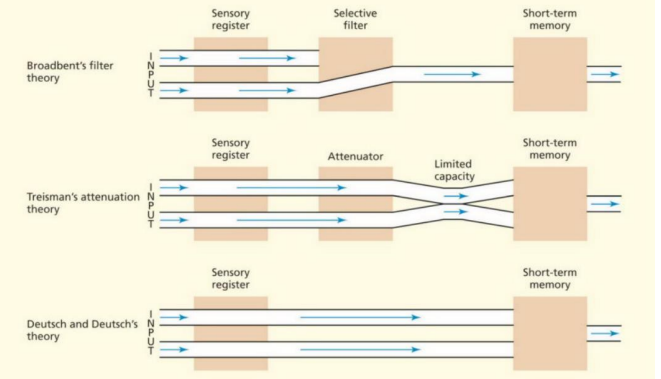
What did wood and cohen 1995 set out to research
which theory of attention is correct?
What method did wood and cohen 1995 use in their experiment exploring attenuation theories
Ran a dichotic listening task
One ear has irrelevant info, the other ear they must repeat out loud a meaningful message to the researcher
In the irrelevant channel, this time, the pps name is said
Researchers monitored the percentage of shadowing errors (messing up '? repeating the meaningful message) pps had in this dichotic listening task
What would wood and cohen’s results look like if filter theory is right
If Broadbent’s filter theory is right, participants should only detect their name if their attention has wandered into the irrelevant channel.
Prediction: More shadowing error before the presentation of the name.
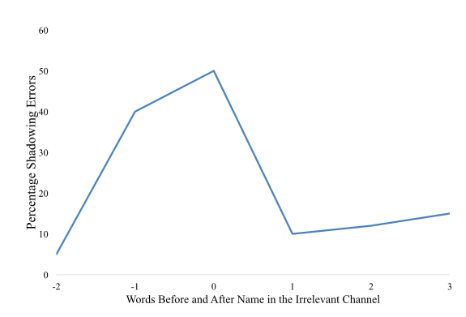
What would wood and cohen’s results look like if attenuation theory is right
If Treisman 1964’s attenuation theory is correct, the name should activate the appropriate lexical unit in the memory only weakly (Attention would be shifted to the irrelevant channel after the name presentation as people would wonder why their name is said)
Prediction: more shadowing errors after name presentation
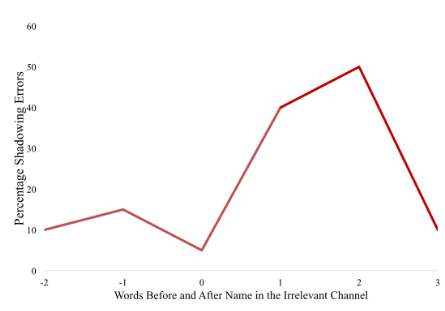
What would Wood and Cohen 1995’s results look like if late selection theory is right
If deutsch and deutsch’s 1963 late selection theory is right, participants would detect their name routinely (would detect their name clearly and loudly each time it is said, causing them to make more errors)
Prediction: More shadowing error during the presentation of the name
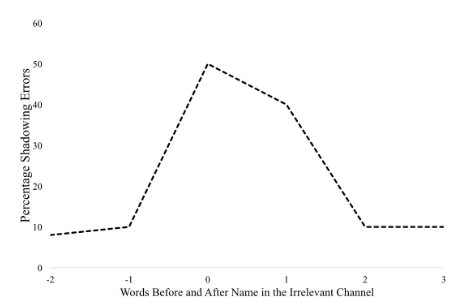
what are Wood and Cohen 1995 results, and which theory does it support
36.6% of the participants recall hearing their name in the channel they were meant to ignore
There was more shadowing error after the presentation of the pps name
These results support Treisman 1964 attenuation theory= winning theory!
What did Neisser and Becklen 1975 do exploring visual shadowing and visual attention
Participants watched 2 superimposed videotapes
Pps were instructed to pay attention to one of the 2 films and to watch for odd events (e.g. watching people shaking their hands)
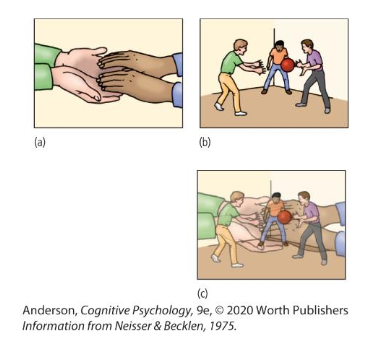
What did Neisser and Becklen 1975 FIND exploring visual shadowing and visual attention, and what does this suggest about visual bottlenecks
When asked to monitor both films for odd events, the participants experienced great difficulty and missed many of the critical events
This means we can also filter visual information, like auditory information
We cannot process all the visual information we see at once; there must be a bottleneck
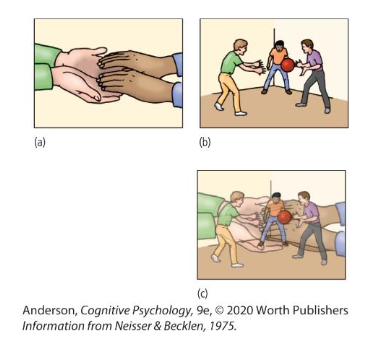
What is Inattentional blindness
the phenomenon whereby we are unaware (unable to detect) what is happening in our direct field of view if we are not paying attention to it
What did Mack and Rock 1998 do exploring inattentional blindness
5000 participants performed a perceptual task in which they judged whether a horizontal or vertical bar of a cross was longer
After a number of trials, there would be a surprise trial in which an additional stimulus such as a rectangle would appear on the screen alongside the cross
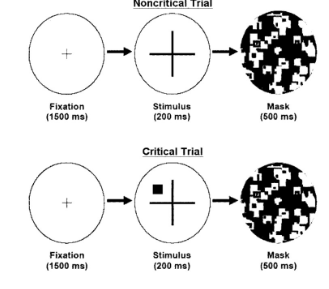
What did Mack and Rock 1998 find in their experiment exploring 1998, and what does this suggest about visual attention
Participants were not able to detect the size of the horizontal/vertical lines when a surprise stimulus was shown
Participants were also more likely to detect the surprise stimulus if it was their name (consistent with the cocktail party phenomenon!)
Thus, we can detect semantic information even though we can’t detect the visual information which we are meant to be paying attention to
What did Simons and Chabris 1999 do in their experiment exploring inattentional blindness?
Participants are asked to watch a video with two teams (black and white).
Participants must either count the number of passes from the black or the white team.
In the middle of the game, a person in a black gorilla suit walk through the room.
What did Simons and Chabris 1999 find in their experiment exploring inattentional blindness? Why does this result make sense?
Almost all participants fail to notice the gorilla when tracking the team in white (92% fail).
Although shocking, this makes sense, as now we know that we cannot process and attend to all the visual information presented to us
How do we process information in the visual field? Which eye connects to which side of the brain
Information about the left side of the visual field goes to the right brain.
Information about the right side of the visual field goes to the left brain.

What is visual neglect?
Absence of awareness of stimuli presented to the opposite side of brain damage (contralesional side).
Damage to which lobe causes defecits in visual attention
Parietal lobe
Which side do most neglect patients have damage
Most neglect patients have damage in the right hemisphere (lack of awareness of stimuli in the left visual field).
What is unilateral visual neglect
Patients with damage to the right hemisphere ignore the left side completely.
Patients with damage to the left hemisphere ignore the right side completely.
What did Sacks 1985 do to display unilateral neglect (right hemisphere only)
The task was to put slashed through all circles.
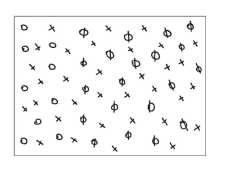
What is the right parietal lobe important for (2) ? What does this mean for image reproduction studies
The right parietal lobe is more important in the spatial allocation of attention (directing our attention).
The right parietal lobe is important for global features.
Patients are able to reproduce specific features of the pictures but not global features.
What is the left parital lobe important for? what does this mean for image reproduction?
The left parietal lobe is important for specific features.
Patients are able to reproduce global features of the pictures but not specific features.
Overall, what are the visual attention limitations?
Inattentional blindness
Neisser and Becklen 1975 2 superimposed videos (cant attend to all info)
Mack and Rock 1998 horizontal/vertical line judgements w/ surprise stimuli (we can detect semantic information even though we can’t detect the visual information which we are meant to be paying attention to)
Simon and Chabris 1999 watching basketball and gorilla (cant attend to all stimuli 92%pps missed gorilla)
Visual neglect
Unilateral neglect
Parietal lobe damage